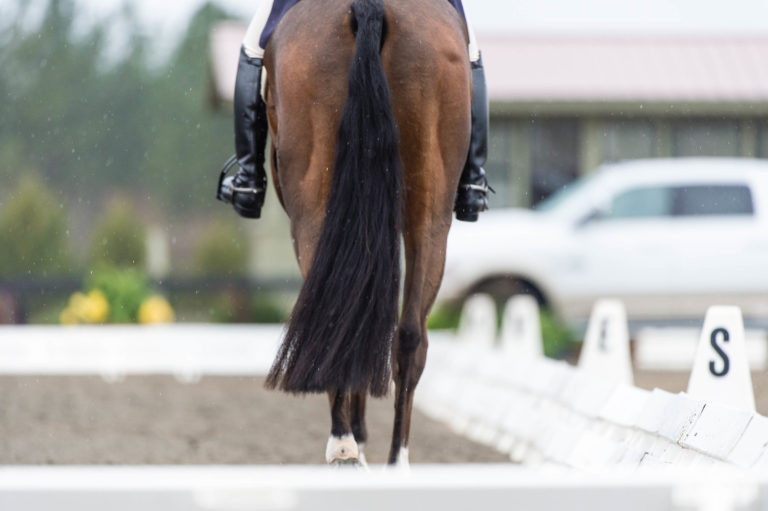Whether you are riding a young horse who is just learning the aids for trot or a Grand Prix horse who must go from passage to canter, you always want to improve transitions. When a horse can perform relaxed, energetic transitions, it is a sign that he is bearing weight on the hind legs and is submissive to the rider’s aids. There is no worse feeling than a horse who launches himself into a canter transition with a stiff back and a disengaged hind leg or a horse who falls on the forehand and drags you into the walk.
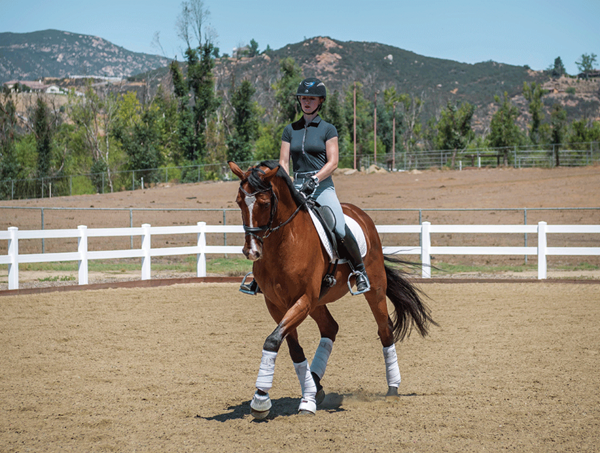
In order to improve my horse’s suppleness and reaction in the transitions, I often incorporate leg yields. There are a lot of details to focus on in a simple leg yield: Is my horse responsive to my leg aids? Does he maintain rhythm and energy? Is he balanced over all four legs without displacing the shoulders or haunches? Will he respond promptly to a half halt and take more weight on his hind leg? If the answer to all of these questions is “yes,” then you already have the components necessary for a perfect transition. Every transition between gaits requires freedom in the horse’s body so that he can easily change from one rhythm to another. This freedom comes when the horse is relaxed, intent on his rider’s aids and bearing weight on his hind legs. In a good transition, the horse should feel like he lifts you calmly into the next gait. Even in a downward transition he should give you this upward feeling.
Understanding Transitions
Before you can improve a transition, you must first understand the basics of each transition by itself. The following will explain the aids a rider should use in the four transitions used in this exercise.
Walk to Trot. Before asking for trot, you must have a steady connection to the bit and the horse nicely in front of your aids. To test this, make sure you can “breathe” with your legs by letting them hang lightly. Are you able to take them away from your horse’s sides without the tempo changing? If you feel your horse is behind you, give a quick correction by squeezing your calves at the girth for one or two strides and then taking them away again. Your leg aid might need to be stronger at the beginning if the horse does not respond promptly.
Repeat this until you feel your horse has an honest reaction to your aids. Once this is accomplished, ask for trot by maintaining a playful contact and squeezing with the length of your leg while you lighten your seat very slightly. This does not mean you need to tip forward or come out of the saddle at all; it is merely a forward thought in which you allow the horse to move forward without blocking him with your seat. If the horse does not have an honest reaction and does not move quickly enough to the trot, use the same technique referred to in the above paragraph. The goal is to be able to use the lightest aid possible. So if you feel yourself having to use a bigger aid each time, address the issue right away until the aid becomes quieter again.
Trot to Walk. To go back to the walk from the trot, you have to half halt. You must tighten your core and begin to stabilize your seat against the motion of the trot. Close your seat and use your thigh by applying steady pressure and gently squeeze the reins. As in the upward transitions, you might have to use a stronger aid at the beginning, but work on becoming softer each time so that the horse really begins to tune in to your seat aid. This will also greatly improve your half halts once these transitions become sharper.
Trot to Canter. To go from the trot to the canter is a little more complicated. You must maintain slight flexion to the inside while keeping a steady contact with the outside rein so that the horse knows which lead you want. Apply slight pressure with the inside leg at the girth while you slide your outside leg back behind the girth. As in the upward transition from the walk to trot, lighten your seat very slightly and prepare for the first stride of canter by keeping your hips loose and ready to move with the motion of the horse. You have to find the right moment in the trot to have a perfect trot-to-canter transition in which the weight is balanced on the horse’s hind leg and you can “scoop” him nicely into the canter.
Canter to Trot. Finally, the canter-to-trot transition is similar to the trot-to-walk transition. You must tighten your core and begin to stabilize your seat against the motion of the canter. Use slight pressure in your hands and squeeze with your thighs to tell the horse to make a downward transition. Start thinking of the two-beat rhythm of the trot in your head so that your body starts to feel the right pattern with the result of your horse finding the rhythm as well.
Although basic, details such as good transitions make a world of difference as your training progresses. Good dressage really comes down to the foundation of each horse and rider. If your work is built upon a solid training foundation then you will have the tools to navigate the harder movements. But if there are cracks in your foundation then you will encounter many more problems down the road. Be sure to continually check up on the basics as your training progresses and you will be amazed at the difference it makes in the long run.
Once you have a basic feel and understanding of these transitions, then you can begin to perfect them by adding leg yield in these exercises:
Exercise 1—Leg Yield in Walk
Before you start, you want to make sure that the horse has a basic knowledge of trot–canter and canter–trot transitions, is steady in the contact and can perform a simple leg yield. A correct simple leg yield should look and feel smooth and seamless. You will be able to feel the horse bending his rib cage around your inner leg while filling up your outside rein. You should feel the horse engage himself as each step crosses up and under his body. The horse should look fairly parallel in his body with slight flexion in the throatlatch as he bends to the inside and a nice curve through his rib cage around your inner leg. You shouldn’t feel as though you have to force the horse sideways. He should willingly move away from the pressure and follow the weight of your seat bones. When done properly, a simple leg yield looks flowing and natural for both horse and rider.
This exercise is best suited for a First Level horse. We will discuss later in the article how the exercise can be adapted for a horse with more or less experience.
1. Develop a medium walk and prepare to go down the centerline by asking for a slight inside flexion and more activity from the horse’s hind legs.
2. Once you have turned onto the centerline, half halt right away to balance the horse after the turn. Ask him to soften around your inside leg and establish shoulder-fore.
3. Ask your horse to leg yield away from your inside leg toward the rail as your inside seat bone drops.
4. A stride or two into the leg yield, make another half halt to say, “stay with me, stay balanced.” Continue with these half halts to encourage the horse to step evenly, keeping his shoulders and haunches parallel to each other.
5. When you reach the rail, move your horse into shoulder-fore position by asking him to soften around your inside leg and half halt on the outside rein.
6. When you feel your horse release in his topline, allow with your hands and ask for a transition to trot.
7. Ride down centerline in trot and again prepare for leg yield toward the rail.
8. As you approach the rail, ask your horse to take shorter, more active strides by decreasing the motion of your seat and energy in your body. If your horse does not get the idea at first, try half halting a little more firmly on the outside rein.
9. When you reach the rail, develop a shoulder-fore position and when the horse’s topline releases, ask for walk.
Photos of Exercise 1:
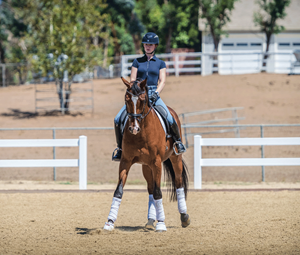
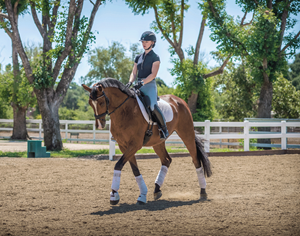
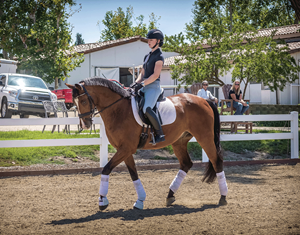
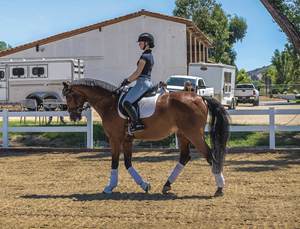
Exercise 2—Leg Yield in Trot and Shoulder-fore in Canter
When you are comfortable with the exercise in walk and trot, try it in trot and canter. The same basic techniques apply in these higher gaits, except classical theory dictates that you never leg yield away from the leading leg in canter because it can put the horse out of balance. So, we will leg yield from the inside leg in the trot–canter transition and do shoulder-fore in the canter–trot transition. The connection in shoulder-fore helps disrupt the three-beat rhythm of canter and encourages the rider to keep her inside leg active throughout the downward transition to trot. When the inside leg is doing its job and creating bend and softness in the horse’s rib cage, he remains solidly connected in the outside rein and supple. The pattern is slightly different in this exercise:
1. Develop working trot sitting and turn down centerline.
2. Ask the horse to leg yield away from your inside leg toward the rail.
3. When you have reached the rail, push the horse away from your inside leg, and with a slightly firmer half halt on the outside rein, develop shoulder-fore.
4. When you feel your horse release through his topline, allow with your hands and ask for canter.
5. Continue through the next corner.
6. As you approach the following long side, turn a little early so that you are about 2 meters from the rail.
7. Confirm your shoulder-fore position and half halt a little more firmly on the outside rein in the downward beat of the canter to make the transition to trot. Then leg yield to the rail.
The beauty of this exercise is that it can be altered to accommodate horses of all levels. For a young or green horse you can start the leg yield from the quarterline or even a few meters off the track. For a more advanced horse you may make the leg yields much steeper. I often use this exercise in the warm-up for my FEI horses to get them supple and reactive to my aids. It is also a really great exercise for teaching the rider how to surround a horse with the aids so that every part of the rider’s body is doing its job and can gently organize the horse without force.
Photos of Exercise 2:
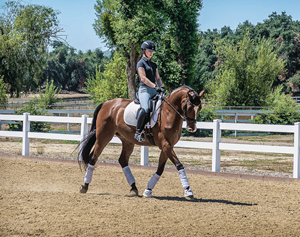
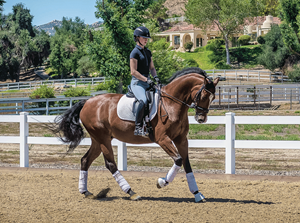
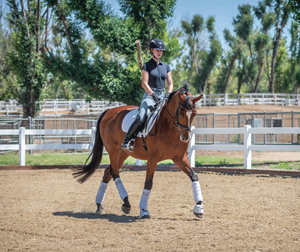
Why It Works
The leg yield is far more than just a simple First Level movement. It helps to supple and engage the horse. When the horse finds the proper amount of self-carriage for his level then the hind legs, particularly the inside hind that crosses over, really engage. Leg yields can teach the horse to lower his croup and begin to sit behind. When the horse is correctly engaged, he creates a bridge of energy from his hind legs through his topline to the contact. When this happens, the horse rounds his back and there is a feeling of positive tension and elasticity through his body. With the horse using his body to his best ability, the rider is not just sitting on the horse, but rather is carried by the horse. The rider now has a great place to sit in correctly and be effective.
How does the engagement achieved in leg yields make for good transitions? Weight-bearing ability is important to a good transition as it balances the horse evenly over his front and back legs. Since horses naturally carry more weight in the front end, if the weight-bearing ability of the hind legs is lost, then the horse will fall on his forehand. This makes it difficult for him to free his shoulders and lift himself into the next gait. If you perform quality leg yields, the horse will engage his hind end. Once those hind legs are working, he has the freedom in the rest of his body to respond quickly to your aids. This freedom is suppleness and this quick response is rideablity.
Relaxation is so important to all of dressage, but it is necessary to distinguish between a horse who is relaxed and a horse who is a little apathetic. This is why I like the phrase “positive tension” to describe a horse who is really listening and responsive to the aids, but is also very comfortable and confident in his work. A horse who has a tendency to be dull to the aids may be very relaxed, but he cannot be truly supple unless he is using his hind legs energetically to create a bridge over his back. At the same time, a very nervous horse is showing negative tension and is too tight over the topline to become supple.
These exercises are beneficial for both types of horses. For the horse who is a bit lazy, the quickness of the exercise encourages him to be more reactive to the aids. For the horse who is too wound up, the leg yield helps him find a nice rhythm and shows him how to use his energy in a positive way so that, in the end, the transition is relaxed and smooth rather than explosive.
Common Problems
Crookedness often arises when the rider allows the horse to get too far ahead of her, pushing past the outside aids and displacing the shoulder or haunches. If you suspect this, ask your horse for halt and assess where his body is. If the horse is overbent and the shoulder is leading, you may need to straighten him with a few more frequent, stronger half halts on the outside rein. If the horse is leading with his haunches, try putting your inside leg closer to the girth and keep your outside leg draped around him, ready to gently nudge him back into alignment should he become crooked.
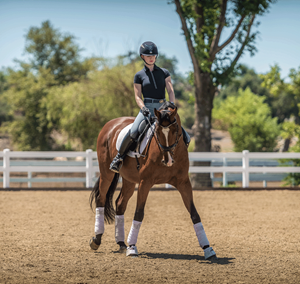
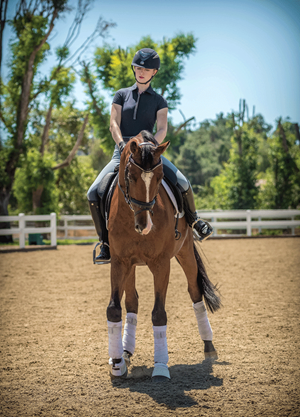
Unresponsiveness. If your horse is not reacting promptly to your aids for sideways movement or for the transition, look at yourself first. If the horse doesn’t respond right away, we often want to use a bigger aid until we just kick the horse to get into the trot, and then that becomes our first aid. This is a good exercise to keep the rider honest because if these problems exist in the leg yield they will be very easy to spot and correct before the transition. If your horse is unresponsive then it may be necessary to bump your aids up a notch until you get a strong reaction. But you must always, always return to using the smallest aid possible.
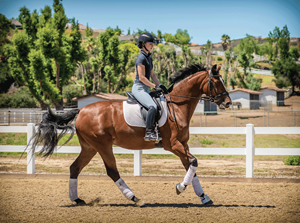
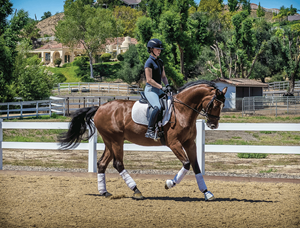
Signs of Success
The difference between feeling a tight and a supple horse is night and day. When you succeed in suppling and relaxing your horse, riding feels and looks effortless, and that’s our goal in dressage. You suddenly have a comfortable place to sit in the saddle as the horse truly engages his hind end and carries you. Your smallest aids get prompt reactions as the horse becomes calm and attentive.
Besides this nice feeling there are visible signs of success in this exercise. The turns down centerline should become easier without the horse becoming crooked or leaning on the aids. When you ask for leg yield, the horse should move promptly sideways, becoming softer in the bridle and lighter in his steps. You should be able to control the tempo and energy of the trot with just your seat. Your half halts should feel as if they move through your body without resistance. You should be able to soften your hand without the horse rushing away or becoming unbalanced. Following this giving part of the half halt you should be able to put your leg on and increase the energy without the horse becoming tense.
When all of this is achieved in the leg yield, then the transitions become very easy. You should feel that the horse carries you easily into the next gait without you having to pull or drive him. You will see that suppleness is the path toward harmony between horse and rider.
Catherine Chamberlain is a USDF bronze, silver and gold medalist and has had a successful FEI Junior/Young Rider career. She competed at the NAJYRC five times, earning two individual gold medals, three team gold medals and three individual silver medals. She also won the 2015 USEF Young Rider National Championships. She trains at Adventure Farms in Murrieta, California, where she works for David Wightman and Kathleen Raine.








